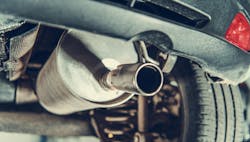FAQs for EVAP testing and system operations
Q: What is the most common cause of EVAP system faults?
A: Leaking purge valves and contaminated vent valves are the most frequent causes in modern systems. Blocked vent lines can also create negative fuel tank pressure and refuelling issues.
Q: How can I differentiate between a small leak and a purge valve fault?
A: A purge valve slightly stuck open can mimic a small system leak. The dedicated Evaporative Emission Canister Purge Valve Leak Test in Snap-on software confirms whether the valve seals properly.
Q: Why is the vent valve so prone to failure?
A: Being located low on the vehicle, the vent valve is exposed to dust, debris, moisture, and road salt. Blockages or corrosion can prevent sealing during leak tests or restrict airflow during refuelling.
Q: What is the fastest way to detect EVAP leaks?
A: A smoke machine, such as the Snap-on Smart Smoke EVAP Machine, allows you to visualise leaks instantly and pinpoint cracked hoses, faulty seals, or blocked lines that are otherwise invisible.
Q: Do all EVAP-related codes indicate a leak?
A: No. Codes like P0443 (purge solenoid electrical fault) or P0446 (vent control electrical issue) indicate electrical or circuit faults rather than leaks. Correct interpretation prevents wasted diagnostic time.
Q: How do Snap-on Guided Component Tests help with EVAP diagnostics?
A: They provide step-by-step instructions, hookup diagrams, and known-good waveforms for purge valves, vent valves, pressure sensors, and leak detection pumps—removing guesswork and speeding up diagnostics.
Q: What's the benefit of using Troubleshooter Tips for EVAP faults?
A: They draw on thousands of real-world repairs to highlight common failure points such as cracked filler necks or contaminated vent valves. Mileage-based graphs show which parts and procedures have successfully resolved the issue.
Q: Can EVAP issues affect engine performance?
A: Yes. Faulty purge or vent valves can create vacuum leaks or fuel-lean conditions, which may trigger drivability issues, reduced fuel efficiency, or check engine lights.
Q: Should I replace the entire EVAP canister if there's a vent blockage?
A: Not always. Many blockages can be cleared by cleaning or replacing the vent valve or line. Snap-on Guided Component Tests help identify exactly which component is at fault, avoiding unnecessary parts replacement.
